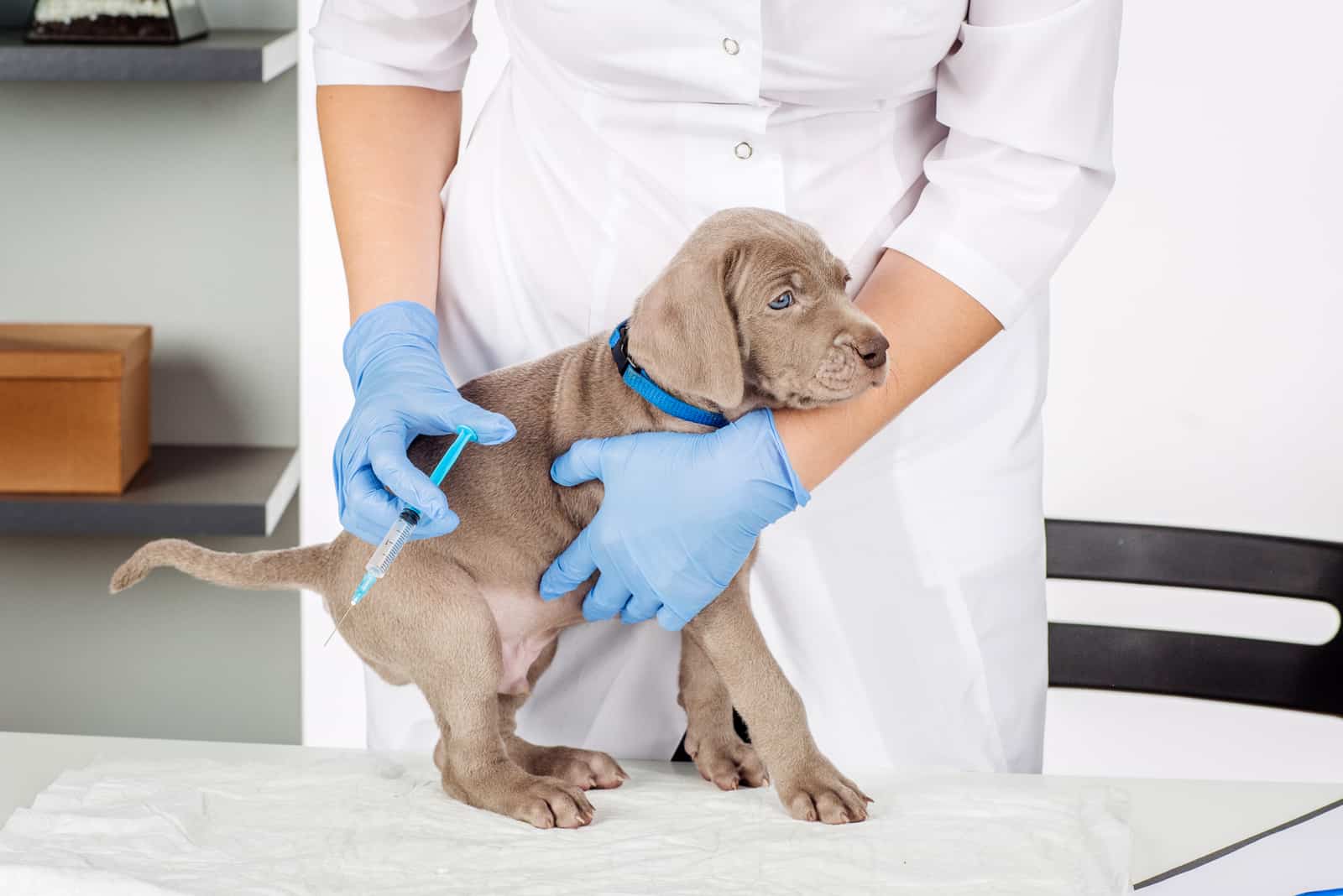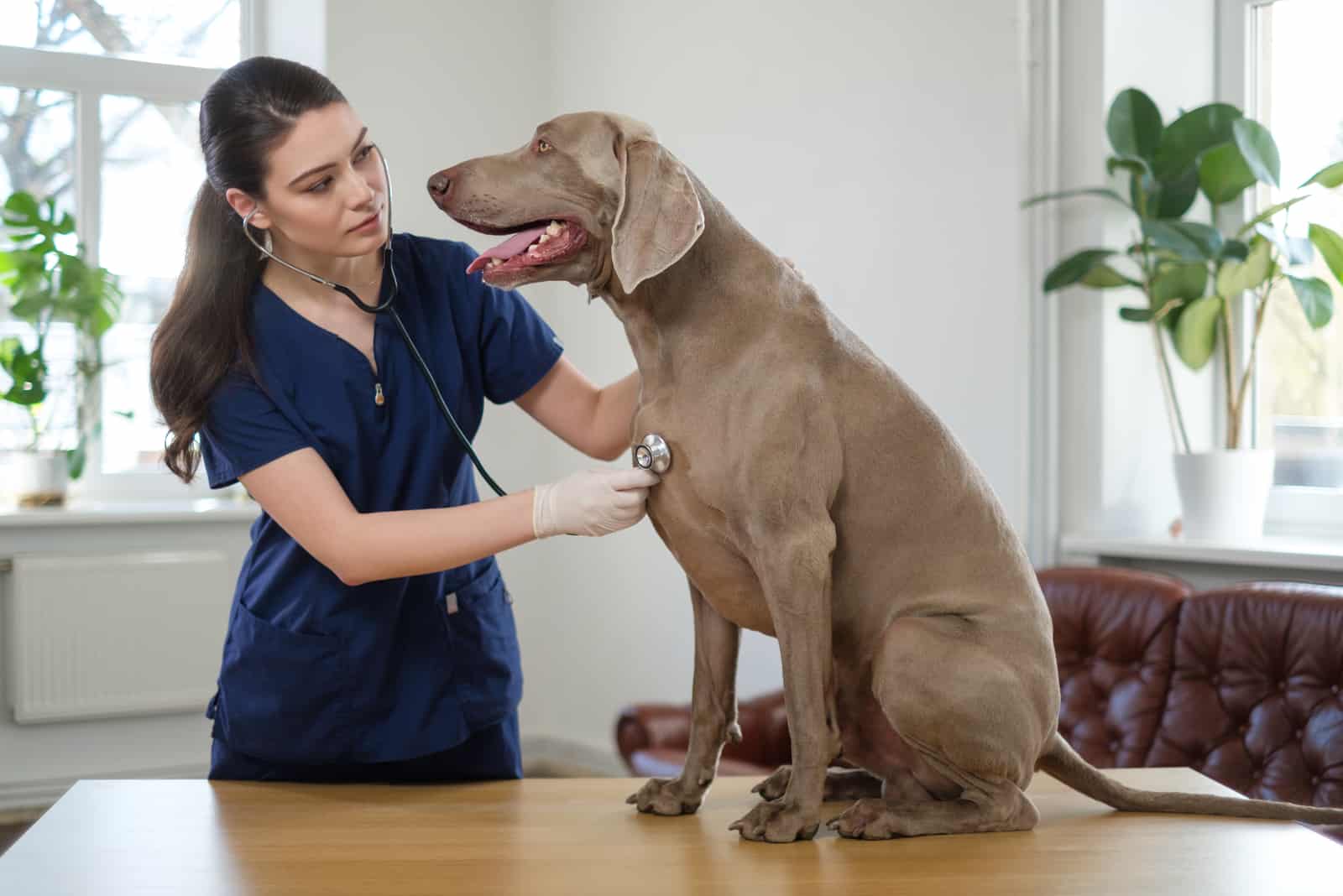The Weimaraner breed isn’t perhaps as well known as some others, and yet it sits at #36 of 204 in the American Kennel Club’s (AKC) most popular dog breeds!
Originally bred in Germany as a hunting dog, the Weim is active, friendly, energetic, and loyal. The Weimaraner is an impressive animal named ‘the gray ghost’ because of its stunning silver-gray coat. It’s sleek, athletic, powerful, and has a proud bearing.
Maybe this beautiful shorthaired dog has caught your eye, and you’re thinking of getting one? If so, you’ll want to know how much it will cost you.
And that’s what we’re here for! In this guide, you’ll find all the information you could possibly need to help you prepare your finances.
Let’s dive in and find out…
How Much Does A Weimaraner Cost?

Many first-time dog owners make the same mistake in that they don’t look further than the initial price of buying the puppy.
Yes, buying a puppy can have a hefty price tag (you can find out more below), but the true cost doesn’t end there. In fact, over the next decade or so, you’ll pay many times that price to care for your dog properly.
Over the course of your Weims life (typically between 10 and 13 years), the total cost will be somewhere between $15,000 and $25,000, not including the initial cost of the puppy!
It’s essential to take note of this, as many people find that they can no longer care for their pets due to financial pressure and are forced to surrender their precious pooches to shelters or rescues. Only take on a dog if you are 100% certain that you can afford it.
Our guide is designed to give you a rough idea of what to expect in terms of puppy price, care, dog food, grooming expenses, and vet bills.
So, when you ask, how much does a Weimaraner cost? The answer has to include all of these aspects.
We’ll begin with buying your pup and take it from there.
How Much Does A Weimaraner Puppy Cost?

The average cost of a purebred Weimaraner puppy in the US is between $500 and $3,000, which is a pretty wide margin.
You can buy a healthy pup from a reputable breeder for around $700, but it’s best to avoid buying too cheaply. Breeding is an expensive business when it’s done right, so cheap puppies are a sign that someone has been cutting corners, usually regarding health tests and caring for the parent dogs.
At the upper end of the puppy price scale, you’re paying for extra health checks and DNA testing, and the breeder’s reputation. The bloodlines and pedigrees will add to the price, but you can keep the cost to around $1,000 for a good quality, healthy pup if you’re not too fussy.
How Much Is A Blue Weimaraner?
Many people believe the blue Weim is rare, but this is not the case. As such, it should be similar in price to any other Weimaraner coat color, maybe slightly more.
Some rarer dogs will cost more, but don’t be fooled by marketing ploys! Good breeders will never take advantage by selling rare or ‘unique’ colored pups at a premium price.
Always Check Out The Breeder
It’s well worth checking reviews and testimonials before buying from a breeder. The good ones welcome this and will be keen for you to visit the site to meet them and their parent dogs. They have nothing to hide and will gladly show you around, answering any questions you may have.
Be prepared to answer some questions yourself! The best breeders always assess their prospective clients thoroughly because they are anxious to send their pups to the best homes.
Of course, more reputable breeders will demand a higher price, but it’s always better not to risk it.
Adoption Fees
To save money, you could check with your local shelters or rescue groups for a Weim. It’s doubtful they’ll have a puppy, and these dogs are rarely seen in shelters, but it’s not impossible.
Adoption fees can be as low as $50 and never usually pass $300, which is more achievable for most people.
Weimaraners On Craigslist
You can pick up a bargain here with pups for as little as $200 to $400. However, we strongly advise against doing this.
According to its own rules, Craigslist prohibits the selling of dogs (or any live animals). However, it still happens! Sellers get around the rules by asking for a rehoming fee. Sites like this are an outlet for backyard breeders and puppy mills. The best advice is to avoid them at all costs.
These dogs are almost always poorly bred, kept in appalling conditions, and the females are forced to produce puppies several times a year. Pups are taken from their mothers way too early, leading to unhealthy puppies with no socialization.
Also, it’s estimated that around 80% of all pups sold online are scams! If you’re concerned about your finances and the Weimaraner cost, stick to adopting from a shelter or buying from a reputable breeder.
Cost Of A Weimaraner Puppy: The First Year

So, you’ve paid your deposit, and you’re waiting for the happy day to arrive. Meanwhile, this is a good opportunity to prepare your home, which takes a bit of time and money.
Your pup’s first year will be the most expensive (assuming that you don’t encounter any nasty surprises later), so you must have a budget worked out to ensure you can cover all the costs.
Puppy Essentials
Here are some examples of what you’ll need, with an average price range:
• Pet insurance – between $200 and $600 (optional but recommended)
• Dog crate – between $50 and $600. It’s essential to get a good one that’s the right size for your pup!
• Bedding/blankets/dog bed – from $50 to $200 for a comfortable bed and $10 to $40 for blankets.
• Nametag – from $6 to $40, depending on how fancy you want to go! These are a great idea in case your pup somehow gets lost.
• Leash/harness – between $5 and $35 for a leash and around $30 for a comfortable, safe harness.
• Collar – from around $5 to $40. These can be personalized and handmade, but you’ll pay more for them.
• Food and water bowls – $10 to $20 each. Stainless steel bowls are the best choice as they are easier to clean and won’t leach harmful chemicals like some plastic or ceramic bowls. Please note: raised feeding bowls have been linked with the condition called bloat! Weims are prone to this potentially fatal condition, so avoid using raised feeding bowls at all costs.
• Puppy food – around $20 to $60 a month. Only use high-quality dog food formulated for puppies. Cheap puppy food is likely to harm your pup and affect its development.
• Dog treats – this is a difficult one, as it’s entirely up to you how many you use! However, they’ll be handy when training your pup, so you’ll get through quite a few. Choose healthy ones where possible and never let them exceed 10% of your pup’s calory intake. On average, dog owners in the US spend between $60 and $300 a year on treats.
• Puppy shampoo – between $8 and $30 for a good brand. While you may get away with using a gentle baby shampoo once or twice, human brands are generally too harsh for dogs and will strip out natural oils that condition their coat.
• Chew toys/dog toys – once again, you can buy as many as you wish! These are important as playtime is fun and helps your pup’s development. Also, you’ll need them when your puppy starts teething! Good quality toys cost between $8 and $20.
• Doggy toothpaste and brush – as with shampoo, you should never use toothpaste designed for humans. For one thing, some brands use an artificial sweetener called Xylitol, which is highly toxic to dogs. A good brush costs around $6, and a quality brand of dog toothpaste is around $10.
• Dog brush and comb – between $8 and $30. Regular brushing is essential for keeping your pup’s coat in good condition and reducing the amount of dog hair in your home.
• Nail clippers – around $15 for a good pair with a safety guard to stop you from clipping too far! Don’t use nail clippers meant for human use, as these aren’t up to the job and can easily hurt your puppy.
• Dog gate/Stair gate – from around $30 to $150 for a decent one. Don’t skimp on this, as these gates must be safe and effective.
This gives an insight as to the cost involved, and there may be items we’ve missed! However, you get an overall sense of what’s involved in setting up your home ready for your pup. Some of these items are one-off buys, but others will need regular replacement.
Economize, by all means, but never compromise on your dog’s safety.
Weimaraner Puppy Vet Bills In The First Year

A good breeder will ensure that your pup gets its first shots between 6 and 8 weeks, but it’s up to you to pay for further vaccinations. A puppy usually has a set of core vaccinations in three sessions. The breeder generally arranges the first session, leaving you to get the next two, which will cost between $75 and $100 for each trip.
These vaccinations should be given annually once your pup reaches one year of age.
There are recommended vaccines and optional vaccines, and it’s entirely your choice whether to get these or not.
In some states, it’s a legal requirment for your dog to have a rabies shot, and these cost about $15 to $20.
Good breeders get their pups microchipped, which is included in the price. However, if this hasn’t been done, it’s wise to get this sorted as soon as possible. The average cost of microchipping is $45, including the cost of the chip, the procedure to install it, and online registration.
Although heartworm is rare in pups (because the larvae take a while to develop), it’s good to get your puppy checked and started on preventative treatment. This costs between $5 and $15 per month. In comparison, treatment for a dog that has contracted heartworm can cost between $500 and $1,100 in total.
Spaying And Neutering
Most breeders stipulate that you get your pup’ fixed’ before a specified time (usually before the puppy is six months old), which is written into the sale agreement. Few breeders will arrange for this procedure before then, as this is considered far too early and will affect their development.
This means the financial burden falls on you. Typically, neutering costs between $35 and $300, while spaying costs more, between $65 and $600. On average, these procedures cost around $150.
It depends on the clinic (low-cost petcare surgeries are designed to help pet owners who are struggling financially) and the size and age of your dog.
Spaying generally costs more as it is a more complex and lengthy procedure.
Weimaraner Cost: Grooming

A regular grooming routine will help to keep your furry companion in good shape and help reduce shedding. It’s not only about looking good; grooming contributes to your dog’s health in several ways.
You’ve already invested in brushes, and these should last a good while. However, you’ll need to buy shampoo fairly frequently, and we have already looked at the cost of this above.
Your grooming routine should include checking and cleaning your dog’s ears to avoid ear infections. You can use cotton balls (never use Q-tips!) or gauze to do this, or you can buy special wipes and an ear cleaning solution. These range from between $7 and $85, depending on the brand and the volume you purchase.
One of the more unpleasant jobs involves checking and expressing your Weimie’s anal glands. It’s a tricky task that few dog owners relish, so it’s best to get your vet to do this. Some groomers perform this task, but they use different methods that don’t empty the glands completely. A vet will generally charge between $15 to $25 for this service.
A groomer can also help with nail trimming if you don’t feel up to the job, which will cost about $10 to $25.
Weimaraner Cost: Health Problems

Sadly, our furry best friends often fall sick and need medical treatment, which can be expensive!
Hopefully, your pup will remain healthy all its life. Even so, it’s best to be aware of potential problems, just in case. Here are some common health conditions that affect Weimaraner dogs and what you might realistically expect to pay to :
• Hip dysplasia is caused by a badly-formed joint that makes the bones grind together. Mild cases can be treated with anti-inflammatories ($2 to $3 per day of use), but severe cases require surgery to replace the hip joint, costing anywhere between $1,700 to $7,000 per hip. X-rays alone cost around $300 when checking the dog for this condition.
• Cancer is a difficult one to cost, as each case is different. As a rough guide, an initial diagnosis can cost around $1,700. The cost of subsequent treatment can be astronomical: chemotherapy can be between $1,000 and $12,000 for a month of treatment. It’s not uncommon for dogs with cancer to require four chemo sessions in a year.
• Bloat* is a condition that primarily affects large dogs with deep chests, like Great Danes, German Shepherds, and Basset Hounds. Adult Weimaraners are particularly prone to this, and you need to be aware of the symptoms so you can act quickly. Surgery is required to fix this problem, and this costs between $2,000 and $5,000 if there are no complications. Many owners opt for euthanasia at this stage purely for financial reasons.
• Eye problems such as entropion and distichiasis cause irritation because of small hairs rubbing on the cornea. Surgery to fix this costs between $1,000 and $2,000. More seriously, progressive retinal atrophy (PRA) is a genetic condition that eventually causes blindness. However, there is no cure at present. Dogs with this condition are prepared for life without sight. While this doesn’t really incur any costs, it comes as little comfort to dog owners.
Healthcare is one of the biggest expenses dog owners face, and each vet visit will make a dent in your finances. This is one good reason for finding yourself a good pet insurance policy!
*Also called gastric dilatation-volvulus (GDV), bloat is a killer. The dog’s stomach inflates and twists around, cutting off the blood flow to vital organs. Emergency surgery is essential or the dog will not survive. Call the vet immediately if you notice your dog dry heaving and unable to vomit, or it is panting, drooling excessively, pacing, distressed, and restless.
One way to reduce the risk of these health problems is to buy your pup from a good, reputable breeder. You’ll probably pay more but save money in the long run. All good breeders start the deworming and heartworm prevention medication, have the pups microchipped, and get a vet to perform a health check.
They also have health screening programs to check the parent dogs for genetic conditions, so you can be confident that your pup is healthy.
Weimaraner Cost: Feeding

Photo from: @gunther.theweim
Dog food obviously takes up a big chunk of your budget, and it requires careful consideration.
Weimaraners are big, with adult dogs weighing between 55 and 90 pounds, and they’ll get through something like 350 pounds of food each year, depending on the dog’s size and activity level.
Your annual dog food bill will probably be between $200 and $550 a year as a result.
Don’t be tempted to opt for cheap foods as they are often packed with grains as fillers and won’t provide the nutrition your dog needs.
Learn more about this dog’s nutritional needs in our Weimaraner feeding chart.
Weimaraner Cost: Training And Socialization

Training and socialization are an essential part of owning a dog, but it is even more critical for some, including the Weim.
Remember, these are hunting dogs. Decades of breeding have enhanced their qualities as retrievers and pointers, giving them a strong prey drive. They are big, energetic, boisterous dogs that can be a danger to small children and animals if not handled properly.
All good breeders begin the socialization process for you, and some provide basic command training.
Either way, it’s definitely a good idea to get your canine companion professionally trained, and this will cost around $1,000.
Dog training classes for the Weim should focus on obedience and socialization, as this will reduce their natural instincts. However, these dogs aren’t recommended for people who keep cats or small pets.
Weims are also highly suspicious of strangers and can be openly hostile and aggressive. This is due to their unwavering loyalty and love* for their owner and family members. Socialization can help with this issue, but they will always be protective and make excellent watchdogs!
*While it’s great that they adore you, it means that separation anxiety is a real problem. Weims don’t like being alone and will become destructive and aggressive, even to the point of harming themselves. Aside from the distress, this could add to the expenses!
Weimaraner Cost: The Takeaway
Although it’s not easy to say this is precisely how much a Weimaraner costs to keep, we can get a basic idea of the expenses involved,
Sadly, too many people take on the responsibility of owning a dog without taking into account the full costs involved. This causes them financial hardship and puts the pet at risk: many dogs wind up in shelters or on the streets, and some face a worse fate.
Before getting a dog, you need to research the breed thoroughly to see whether it’s right for you and your lifestyle. You should also look into how much it will cost and whether you can afford to give the dog the care it needs and deserves.
The average lifespan of the Weim is between 11 and 14 years. That means you need to be committed to providing everything your dog needs throughout this time, and it will cost you a pretty sizable sum of money.
As we stated at the beginning, this could be as much as $25,000, and that’s without other costs such as dog walking/sitting services, boarding kennels, or daycare!
Of course, life isn’t always predictable and will throw curveballs at you. However, you should prepare your finances as far as possible to ensure that your furry friend is looked after.
It’s a good idea set a budget and stick to it, though there can be some flexibility.
Finally, getting a dog involves responsibility and commitment, but if you accept this and put in the effort, the rewards are worth it.
Read Next: Vizsla Vs Weimaraner: Which Breed Is Better For Your Family


